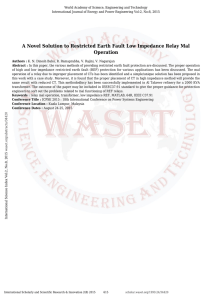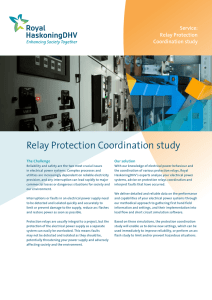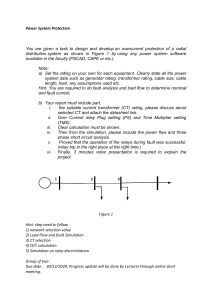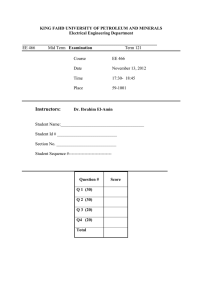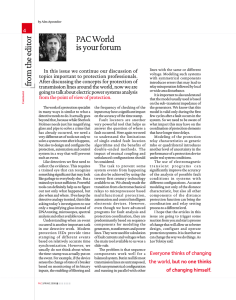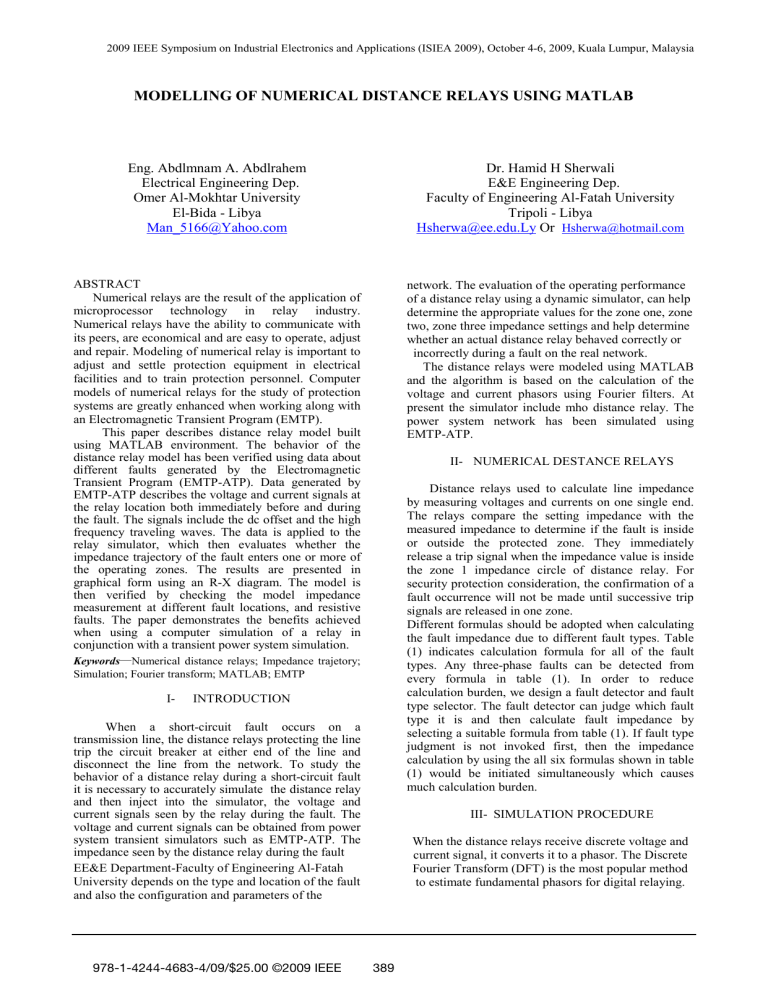
2009 IEEE Symposium on Industrial Electronics and Applications (ISIEA 2009), October 4-6, 2009, Kuala Lumpur, Malaysia MODELLING OF NUMERICAL DISTANCE RELAYS USING MATLAB Eng. Abdlmnam A. Abdlrahem Electrical Engineering Dep. Omer Al-Mokhtar University El-Bida - Libya Man_5166@Yahoo.com Dr. Hamid H Sherwali E&E Engineering Dep. Faculty of Engineering Al-Fatah University Tripoli - Libya Hsherwa@ee.edu.Ly Or Hsherwa@hotmail.com ABSTRACT Numerical relays are the result of the application of microprocessor technology in relay industry. Numerical relays have the ability to communicate with its peers, are economical and are easy to operate, adjust and repair. Modeling of numerical relay is important to adjust and settle protection equipment in electrical facilities and to train protection personnel. Computer models of numerical relays for the study of protection systems are greatly enhanced when working along with an Electromagnetic Transient Program (EMTP). This paper describes distance relay model built using MATLAB environment. The behavior of the distance relay model has been verified using data about different faults generated by the Electromagnetic Transient Program (EMTP-ATP). Data generated by EMTP-ATP describes the voltage and current signals at the relay location both immediately before and during the fault. The signals include the dc offset and the high frequency traveling waves. The data is applied to the relay simulator, which then evaluates whether the impedance trajectory of the fault enters one or more of the operating zones. The results are presented in graphical form using an R-X diagram. The model is then verified by checking the model impedance measurement at different fault locations, and resistive faults. The paper demonstrates the benefits achieved when using a computer simulation of a relay in conjunction with a transient power system simulation. network. The evaluation of the operating performance of a distance relay using a dynamic simulator, can help determine the appropriate values for the zone one, zone two, zone three impedance settings and help determine whether an actual distance relay behaved correctly or incorrectly during a fault on the real network. The distance relays were modeled using MATLAB and the algorithm is based on the calculation of the voltage and current phasors using Fourier filters. At present the simulator include mho distance relay. The power system network has been simulated using EMTP-ATP. II- NUMERICAL DESTANCE RELAYS Distance relays used to calculate line impedance by measuring voltages and currents on one single end. The relays compare the setting impedance with the measured impedance to determine if the fault is inside or outside the protected zone. They immediately release a trip signal when the impedance value is inside the zone 1 impedance circle of distance relay. For security protection consideration, the confirmation of a fault occurrence will not be made until successive trip signals are released in one zone. Different formulas should be adopted when calculating the fault impedance due to different fault types. Table (1) indicates calculation formula for all of the fault types. Any three-phase faults can be detected from every formula in table (1). In order to reduce calculation burden, we design a fault detector and fault type selector. The fault detector can judge which fault type it is and then calculate fault impedance by selecting a suitable formula from table (1). If fault type judgment is not invoked first, then the impedance calculation by using the all six formulas shown in table (1) would be initiated simultaneously which causes much calculation burden. Keywords—Numerical distance relays; Impedance trajetory; Simulation; Fourier transform; MATLAB; EMTP I- INTRODUCTION When a short-circuit fault occurs on a transmission line, the distance relays protecting the line trip the circuit breaker at either end of the line and disconnect the line from the network. To study the behavior of a distance relay during a short-circuit fault it is necessary to accurately simulate the distance relay and then inject into the simulator, the voltage and current signals seen by the relay during the fault. The voltage and current signals can be obtained from power system transient simulators such as EMTP-ATP. The impedance seen by the distance relay during the fault EE&E Department-Faculty of Engineering Al-Fatah University depends on the type and location of the fault and also the configuration and parameters of the 978-1-4244-4683-4/09/$25.00 ©2009 IEEE III- SIMULATION PROCEDURE When the distance relays receive discrete voltage and current signal, it converts it to a phasor. The Discrete Fourier Transform (DFT) is the most popular method to estimate fundamental phasors for digital relaying. 389 2009 IEEE Symposium on Industrial Electronics and Applications (ISIEA 2009), October 4-6, 2009, Kuala Lumpur, Malaysia Table 1: Input signals of ground and phase distance relays Distance Element Phase A Voltage signal Current signal Va Ia +3K0I0 Phase B Vb Ib +3K0I0 Phase C Vc Ic +3K0 I0 Phase A - Phase B V a − Vb Ia − Ib Phase B - Phase C Vb − Vc Ib − Ic Phase C - Phase A Vc − Va Ic − Ia Read and store V, I from EMTP/ATP Low pass Filter Compute Z using DFT algorithm for a-g a-b, fault When a fault occurs on transmission lines, the voltage and current signals are severely distorted. These signals may contain decaying dc components, subsystem frequency transients, high frequency oscillation quantities, and etc. The higher frequency components can be eliminated using low pass antialiasing filters with appropriate cut-off frequency, but the anti-aliasing filters cannot remove decaying dc components and reject low frequency components. This makes the phasors very difficult to be quickly estimated and affects the performance of digital relaying. Therefore, the Discrete Fourier transform is usually used to remove the dc-offset components. The voltage and current data are derived using an EMTP-ATP model of the power system. These data are then converted to a MATLAB. The sampling rate used in the distance relay is 1.0 kHz. i.e (20 sample/cycle). The samples are 1ms a part. Sample V, I Dc-offset correction And Compute V, I phasor using DFT Figure 1, distance relay modeling procedure. IV- DISCRETE FOURIER TRANSFORMER ALGORITHMS (DFT) When a power system is operating under steadystate conditions, both the voltage and the current signals are periodic and the fundamental frequency component of each is at the power frequency. Therefore it is possible to calculate the impedance corresponding to a given voltage and current by determining the fundamental components of voltage and current using a discrete Fourier transform (DFT) technique. Assuming the N samples are obtained for each period and that discrete time signals are X (K ) then sampled signals are given as in equation (1). EMTP-ATP has been used to generate, the data at a 100 kHz sampling rate this allows the effect of traveling waves to be included in the signals. The sampling rate of the EMTP-ATP output file is reduced from 100 kHz to 1 kHz. After that the data input to digital filter "low pass filter" using cut-off frequency 360Hz this to remove the effects on the voltage and current signals of the traveling waves instigated by the fault. The data then be input to Discrete Fourier Transformer DFT window. The DFT is ideal method of detecting the fundamental frequency component in a fault signal. However, DFT, Least Error Square LES and Walsh Function algorithms are among the most popular phasor estimation techniques employed in numerical relays. As result, the magnitude and the phase angle of voltage and current obtained for the input signal, where it is then transformed to rectangular form. The model is then proceeded to calculate the value of resistance and reactance of the line as seen by the relay by using the equations (3) and (4). Figure 1, shows block diagram for distance relay modeling procedure. MATLAB program was used then to plot on graph characteristic of mho distance relay the behavior of Z during the sampling period. X (n ) = X1 = N −1 ∑ X ( k ). e ⎛ 2 Π nk ⎞ −i⎜ ⎟ ⎝ N ⎠ ………….(1) k =0 2 2 .N N −1 ∑ X k .e ⎛ 2 Π nk ⎞ −i ⎜ ⎟ ⎝ N ⎠ …………(2) k =0 Where n is the order of the harmonics. The fundamental frequency signals are the ones with n=1.k is the number of samples contained in the data window. In equation (2) all the N samples are used in the calculation of the fundamental frequency signal, resulting in a full cycle Discrete Fourier Transform (DFT). The extraction of fundamental frequency components of voltage and current signals via discrete Fourier transformer is used and then impedance calculation, resistance and reactance is calculated from voltages and currents samples (K) at relaying point as in (3) and(4). RK = X K = VK I K + 3 . Re( K 0 ). I 0 K VK I K + 3 . Im( K 0 ). I 0 K K 0 is Zero compensation factor = 390 …….. (3) …….. (4) 2009 IEEE Symposium on Industrial Electronics and Applications (ISIEA 2009), October 4-6, 2009, Kuala Lumpur, Malaysia = 1 3 VI- SIMULATION RESULTS ⎛ Z0 ⎞ ⎜⎜ − 1 ⎟⎟ Z ⎝ 1 ⎠ The developed mho distance relay model is evaluated using data generated from EMTP. A single 220 kV over head line with length of 120 Km and a source with above sequence impedances is simulated. The overhead line is modeled as a lumped π model. Different fault locations on the transmission line with different arc resistances were simulated by EMTP. The behavior of the mho distance relay model is as explained hereinafter. Case one: - Single line to ground faults at different distances from the relay location. V- POWER SYSTEM PARAMETERS A Single line diagram of the simulated power network operating at 220kV 50 Hz is shown in figure 2a. The positive and zero sequence impedance of the source are Zs0= 3.681+j24.515 Zs1=0.819+j7.757 BUS B BUS A 10km BUS D BUS C 30km 30km 50km Single line to ground faults were set on EMTP model of the shown power system at 10 Km, 15 Km and 25 Km from the location of bus-A. The lengths are representing 10% to 80% of line A-B length,. Similarly few more Single line to ground faults at 5 Km, and 10 Km from the location of bus-B and bus-C were set. The voltage and current signal before and during fault were fed to the relay model. Figures 2 to 5, Show the impedance trajectory for these cases. In all cases the output results which are the impedance trajectory of the digital distance relay model had the expected behavior where the impedance trajectory calculations start the trajectory from the load area, before fault, and end up at the proper zone. R Figure 2: Single line diagram of simulated power network. The current transformer ratio is 1000/1A and the voltage transformer ratio is 220kV/110V. Setting of the relay is Zone-one = 6.5 ohm-secondary (80 percent of protected line1). Zone-two = 11.23 ohm-secondary (100 percent of protected line1+ 50 percent of the line 2). Zone-three = 16.34 ohm-secondary (100 percent of protected lines 1 and line 2 + 20 percent of line 3). Arc Resistance The single line to ground fault is the most common fault that occurs on transmission line due to the nature of climates .When it occurs it is usually accompanied by a fault resistance, i.e. resistive line faults. The value of the arc resistance can be calculated by knowing the length of the arc. The relation is: R = ARC 2500 I ⋅ l ARC [Ω ] ARC 20 15 jX 10 5 0 Where: lARC =Ar -5 -15 c length in m IARC =arc current in A. For various voltage levels, the following average values may be used: -10 -5 0 5 10 15 20 25 30 R Figure 3: Trajectory of phase-to-ground fault at 10 Km from bus A, impedance Z f = .19 + 1.98j 25 20 Table 2: Typical arc resistance Arc- resistance Voltage level At Isc = 1000A jX 15 10 At Isc = 10000A 5 0 380kv 27.5 Ω 2.75 Ω 220kv 17.5 Ω 1.75 Ω -10 -5 0 5 10 R 15 20 25 30 35 Figure 4: Trajectory of phase-to-ground fault at 35 Km from bus A, impedance Z f = 0.89 + 6.75j 391 2009 IEEE Symposium on Industrial Electronics and Applications (ISIEA 2009), October 4-6, 2009, Kuala Lumpur, Malaysia 25 20 20 15 jX jX 15 10 10 5 5 0 0 -5 -5 -10 -5 0 5 10 15 R 20 25 30 35 -15 -10 -5 0 5 40 10 R 15 20 25 30 Figure 7: Trajectory of phase-to-ground fault at 10Km from bus-A with 2 Ω resistance, impedance Z f =0 .88 + 1.99j Figure 5: Trajectory of phase-to-ground fault at 10 Km from bus B, impedance Z f = 1.14 + 9.55j 25 25 20 20 15 jX jX 15 10 10 5 5 0 0 -5 -10 -5 0 5 10 R 15 20 25 30 35 -15 -10 -5 0 5 10 15 20 25 30 R Figure 6: Trajectory of phase-to-ground fault at 5 Km from bus C impedance Zf = 1.83 + 14.005j Figure 8: Trajectory of phase-to-ground fault at 10Km from bus-A with 5 Ω resistance, impedance Z f = 1.89 + 2.01j Case two: Faults accompanied by a resistance Single line to ground faults with different fault resistance were set on EMTP model of the shown power system at different fault locations. Figures 7 to 9, Show the impedance trajectory for few of these cases. In all cases the output results which are the impedance trajectory of the digital distance relay model had the expected behavior where the effect of the arc resistance reflected on the value of the impedance seen by the relay. Impedance trajectory calculations start the trajectory from the load area, before fault, but, in few results, due to the resistance the relay misjudges the exact location of the fault. 20 jX 15 10 5 0 -5 -10 -5 0 5 10 R 15 20 25 30 Figure 9: Trajectory of phase-to-ground fault at 10Km from bus-A with 10 Ω resistance impedance Z f = 3.54 + 2.09j 392 35 2009 IEEE Symposium on Industrial Electronics and Applications (ISIEA 2009), October 4-6, 2009, Kuala Lumpur, Malaysia VII- CONCLUSIONS The impedance's trajectory after faults represents numerical output of the impedance calculation. The output results reflected the behavior of the developed model under different fault locations and at different arc resistances. The simulation study presented in this paper assist in demonstrating the importance of and requirement for accurate dynamic modeling of distance protection relays. Different case studies have been presented in order to illustrate the response of the developed distance relay model at different operating scenarios, i.e. non-resistive faults and resistive faults. For the particular system studied it was found that the three-zone protection would not see a fault at the reach setting, resistive fault causes the relay to under-reach. The exact and misjudgment of the fault location in the cases demonstrated in this paper reflects the accuracy of the developed model. It is noted that the impedance's trajectory after faults were depends on digital filter type and relay algorithm. The distance relay model may be used as a training tool to help users understand how the relay works. The distance relay model offers an inexpensive alternative to evaluating a relay on a test set and generally will involve significantly less time and effort. REFERENCES [1] [2] [3] [4] [5] [6] [7] [8] Gerhard Ziegler “Numerical Distance Protection”, December 2005, second edition. Abdelsalam Omar Ahmed “protection system performance Analysis Using Dynamic Modeling Methods", proceedings of the fourth Libyan arab international conference, Tripoli Libya, March 2006. Trin Saengsuwan, Peter Crossley "Simulation of Distance Relays for Protection Performance Evaluation", International symposium on electric power engineering, Stockholm power tech. Stockholm Sweden pp 491-496, June 94. “Power System Protection, Volume 4: Digital Protection and Signaling”, The Institution of Electrical Engineering, IEE, London 1995. Abdlmeam A. Abdlrahem, "Modeling of distance relay for power system protection," M.Sc. dissertation, Dept. EE&E., Faculty of Engineering, Al-Fatah univ., Fall 2007. ATPDraw for windows Version4.0p2 copyright 1998-2003 user's Manual, Sintef. The Output Processor (TOP), copyright 1998-2001. MATLAB User's guide, The Math Works Inc., 2006. 393
